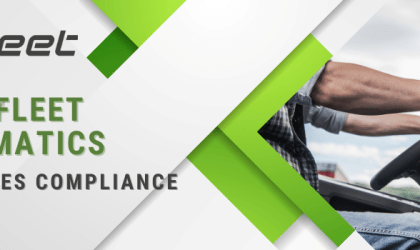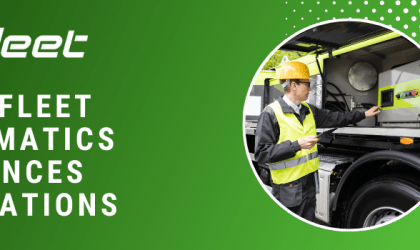What Enterprise Fleet Managers Need from a Telematics Dashboard (But Aren’t Getting)
Your team doesn’t need more data—they need direction.
Many fleet managers have invested in telematics dashboards promising “real-time visibility,” only to find themselves overwhelmed by an influx of charts, alerts, and numbers that obscure actionable insights. This data deluge can lead to analysis paralysis, hindering effective decision-making.
A common pain point is the lack of resources and manpower to extract and interpret the vast amounts of data provided by these systems. Fleet managers often find themselves without the necessary support to translate data into meaningful actions, resulting in missed opportunities for efficiency and cost savings.
Moreover, the complexity of managing data from various sources can lead to integration challenges, where disparate systems fail to communicate effectively, further complicating the fleet management process.
This blog will expose the blind spots in existing dashboards and explore what an enterprise-grade solution should deliver—going far beyond basic maps and markers to provide clear, actionable insights that drive efficiency and profitability.
Visibility Isn’t Enough—Context Matters
Knowing the real-time location of your vehicles is valuable, but without context, that information can be misleading or even useless. Imagine you’re a logistics manager monitoring your fleet. You notice a vehicle has been stationary for an extended period. Is it a scheduled stop, an unscheduled break, or has the vehicle broken down? Without contextual information, you’re left guessing, which can lead to delays, increased operational costs, and dissatisfied customers.
The Importance of Contextual Data
A comprehensive telematics dashboard should provide more than just dots on a map. It should integrate various data points to offer a holistic view of each situation. For instance:
- Location Insights: Is the vehicle at a maintenance facility, a customer location, or stranded on the roadside?
- Environmental Factors: Are there adverse weather conditions or traffic incidents contributing to delays?
- Driver Behavior: Is there a pattern of hard braking or rapid acceleration that could indicate potential issues?
Integrating this contextual information transforms raw data into actionable insights, enabling fleet managers to make informed decisions promptly.
Real-World Implications
Consider a scenario where a delivery truck is idling longer than usual. Without context, this could be overlooked or misinterpreted. However, if the dashboard indicates that the vehicle is in heavy traffic due to an accident ahead, the manager can proactively inform customers of potential delays, adjust delivery schedules, or reroute other vehicles to maintain service levels.
Moreover, understanding driver behavior in context can enhance safety protocols. For example, frequent hard braking in a particular area might indicate a problematic route or the need for additional driver training. Addressing these insights can lead to reduced accident rates and improved driver performance.
The Bottom Line
Visibility without context can lead to misinformed decisions and operational inefficiencies. A telematics dashboard that integrates contextual data empowers fleet managers to understand not just where their vehicles are, but why they are there and what actions to take next. This depth of insight is crucial for optimizing fleet performance, enhancing safety, and delivering exceptional customer service.
Data Overload Without Decision Support
Even when dashboards offer more context, another problem surfaces fast—information overload.
Knowing why something’s happening is only helpful if you can act on it. But most enterprise dashboards bombard managers with alerts, pings, and fault codes—without telling them what to do next. You go from playing detective to drowning in diagnostics.
Take construction fleets, for example. Dozens of fault codes might roll in during a single shift—everything from low tire pressure to diesel particulate filter warnings. Without a clear hierarchy, you’re left guessing which ones are mission-critical and which can wait. That uncertainty leads to reactive maintenance, delayed repairs, and rising costs.
And it’s not just anecdotal—fleets with 300+ vehicles can receive upwards of 7,000+ alerts per day, depending on how telematics are configured (FleetMaintenance.com).
So what’s the fix?
Advanced dashboards are starting to integrate AI-powered triage—systems that don’t just display data but help you act on it.
The right solution will:
- Prioritize alerts based on severity and operational impact.
- Provide recommended next steps, not just error codes.
- Surface patterns across your fleet—like recurring faults tied to certain vehicle models or routes.
Imagine logging in and seeing a ranked task list instead of a red wall of noise. One look, and you know what to do today, what can wait, and what might indicate a systemic issue.
When data is filtered through logic, not just dumped on your screen, managers can stop reacting and start planning.
Lack of Cross-Vehicle, Cross-Region Intelligence
Building upon the need for actionable insights over mere data visibility, another critical shortfall in many telematics dashboards is the lack of cross-vehicle and cross-region intelligence. Enterprise fleet managers often find themselves viewing their vehicles in isolation, missing the comprehensive analysis required for strategic decision-making.
The Challenge of Fragmented Data
Consider overseeing a utility company with a fleet exceeding 150 vehicles dispersed across multiple regions. Evaluating which teams operate more efficiently or identifying consistently underperforming vehicle models becomes a daunting task without integrated data. This siloed approach hampers the ability to benchmark performance, allocate resources effectively, and implement fleet-wide improvements.
The Need for Fleet-Level Intelligence
An ideal telematics dashboard should transcend basic tracking by offering:
- Regional and Vehicle-Type Filtering: Enabling managers to assess performance metrics specific to regions, roles, or vehicle categories.
- Fuel Performance Benchmarking: Facilitating comparisons of fuel efficiency across teams to pinpoint areas for improvement.
- Asset Utilization Analysis: Providing insights into how assets are deployed across regions, aiding in optimal distribution and utilization.
Real-World Implications
For instance, a fleet management system that integrates comprehensive analytics can help in identifying patterns such as higher maintenance costs associated with specific vehicle models or increased fuel consumption in particular regions. By addressing these insights, companies can implement targeted strategies to enhance overall efficiency.
The Bottom Line
Without cross-vehicle and cross-region intelligence, fleet managers are navigating without a complete map. Implementing a dashboard that consolidates and analyzes data across the entire fleet empowers managers to make informed decisions, optimize operations, and drive substantial cost savings.
Real Operational Modeling, Not Just Retrospective Data
While traditional telematics dashboards provide retrospective data, they often fall short in offering predictive insights necessary for proactive decision-making. Enterprise fleet managers require tools that not only report past performance but also forecast future scenarios to optimize operations effectively.
The Challenge of Retrospective Data
Relying solely on historical data limits a manager’s ability to anticipate and mitigate potential issues. For instance, knowing that a delivery route consumed more fuel than expected last week doesn’t help in reducing costs for the upcoming schedules. Managers need the capability to simulate how changes today will impact future outcomes, such as estimated arrival times, fuel consumption, and overall efficiency.
The Role of Predictive Analytics
Implementing predictive analytics transforms fleet management by:Cprime+6AmconSoft+6cartrack.us+6
- Forecasting Future Events: Utilizing current and historical data to predict potential challenges, enabling managers to address issues before they escalate.
- Simulating Decision Outcomes: Allowing managers to model various scenarios, such as reassigning drivers or altering routes, to understand potential impacts on efficiency and costs.
- Proactive Risk Planning: Anticipating risks like traffic congestion or adverse weather conditions, facilitating preemptive adjustments to maintain service levels.
Real-World Applications
Consider a logistics company managing 100 daily routes. By integrating predictive analytics, they can simulate the effects of rerouting decisions in real-time, assessing impacts on delivery schedules and fuel usage. This proactive approach not only enhances operational efficiency but also contributes to significant cost savings.
The Bottom Line
Transitioning from retrospective analysis to predictive modeling empowers fleet managers to move beyond reactive strategies. By forecasting and simulating future scenarios, they can make informed decisions that optimize performance, reduce costs, and enhance customer satisfaction.
Telematics Without Driver Insights = Half the Picture
While telematics dashboards excel at monitoring vehicle performance, many overlook a crucial component: the driver. Without integrating real-time driver insights, fleet managers are left with an incomplete picture of their operations.
The Importance of Driver Behavior Monitoring
Monitoring driver behavior is essential for enhancing fleet safety and efficiency. By analyzing metrics such as speeding, harsh braking, and rapid acceleration, fleet managers can identify risky behaviors and provide tailored feedback and training to drivers. This proactive approach not only reduces accidents but also leads to significant cost savings. For instance, tracking driver behavior and vehicle health has been reported to reduce incidents by 80% on average and accident claim costs by 50%
.
Real-World Applications
Consider a scenario where a driver has multiple speeding incidents and instances of distracted driving. A dashboard equipped with driver coaching features can:
- Create Individual Driver Profiles: Highlighting safety trends and pinpointing areas needing improvement.
- Generate Real-Time Safety Scores: Providing immediate feedback to drivers, encouraging self-correction.
- Offer Video Footage for Coaching: Utilizing dash cams to review specific events, facilitating targeted coaching sessions.
Implementing such features leads to safer, more efficient drivers who contribute positively to the fleet’s overall performance. In fact, 72% of fleet professionals report that telematics, combined with training, helped them reduce crashes and claims.
The Bottom Line
Integrating driver insights into telematics dashboards transforms data into actionable strategies. By focusing on both vehicle and driver performance, fleet managers can proactively address issues, enhance safety, and achieve substantial cost reductions.
No Customization for Industry-Specific Workflows
While integrating telematics dashboards with existing systems enhances operational efficiency, another critical aspect often overlooked is customization for industry-specific workflows. Many fleet management solutions adopt a one-size-fits-all approach, failing to address the unique requirements of different industries.
The Challenge of Generic Solutions
Consider the construction industry, where fleet managers must monitor not only vehicle locations but also equipment usage, site boundaries, and operator hours. Generic dashboards may lack functionalities like Power Take-Off (PTO) tracking, geofence enforcement, and detailed time logs, leading to inefficiencies and potential compliance issues.
The Solution: Tailored Fleet Management Software
An effective fleet management system should offer:
- Industry-Specific Modules: Features designed to meet the distinct needs of various sectors, such as equipment health monitoring for construction or refrigeration status for cold chain logistics.
- Customizable Alerts: Notifications tailored to relevant metrics and thresholds, ensuring timely responses to critical events.
- Flexible Permission Layers: Access controls that align with organizational roles and responsibilities, safeguarding sensitive information.
Real-World Implications
A construction firm implementing a customizable fleet management system can effectively monitor equipment hours, enforce geofenced boundaries to prevent unauthorized use, and maintain accurate time logs for billing. This level of customization leads to improved operational efficiency, reduced unauthorized equipment usage, and precise client invoicing.
The Bottom Line
In industries with specialized workflows, generic fleet management dashboards fall short. Investing in a solution that offers extensive customization ensures that the software aligns with specific operational needs, leading to enhanced efficiency, compliance, and profitability.
Is Your Dashboard Showing Data or Driving Decisions?
You’ve seen how generic dashboards fall short—from ignoring industry-specific needs to drowning you in disconnected data. So here’s the bigger question: is your dashboard helping you move forward—or just keeping you informed after the fact?
Because at the enterprise level, insights without direction aren’t enough.
A powerful telematics dashboard should do more than just report what happened. It should empower your team to act quickly, plan smarter, and run leaner across every region, role, and vehicle.
What does that look like?
- Dashboards that surface critical issues—not just list them.
- Systems that sync across your tech stack, not silo your operations.
- Insights tailored to your industry, not watered down to fit every fleet.
If your current solution isn’t making your job easier, it’s not doing its job.
It’s time to demand more from your dashboard. Not just more data—but more decision-making power, more visibility where it matters, and more tools to take control of what happens next.
Because better insights don’t just make better fleets—they help you own the road ahead.
Ready for a Dashboard That Actually Works for You?
You don’t need more charts, alerts, or red flags—you need clarity, support, and a system that knows your business.
At GoFleet, we don’t just sell telematics. We build custom solutions based on your industry, workflow, and operational goals. Whether you manage 30 vehicles or 3,000, our platform brings real-time insights, smart automation, and decision-ready dashboards that actually drive action.
We help you cut through the noise with:
Smart alert prioritization so you know what matters right now
AI-driven recommendations based on your fleet’s unique behavior
Cross-fleet, cross-region visibility that simplifies your decisions
Tailored integrations built for construction, logistics, utilities, and more
A dedicated consultant—yes, a real person—to support your goals
Stop reacting. Start leading.
Book your free consultation with GoFleet today and get a dashboard that finally delivers what it promises: control, clarity, and real results.



